Continental Conveyor Idlers: Optimal Material Handling
Continental conveyor idlers are the backbone of a vast range of conveyor systems used across various industries. Continental conveyor idlers are engineered to support the conveyor belt and the material being transported along the length of the system. Their main role is to ensure smooth movement of goods and reduce friction between the belt and structure, thus minimizing wear, prolonging system life, and cutting downtime and costs, enhancing productivity and cost-efficiency.
What are Continental Conveyor Idlers
The Definition of Continental Conveyor Idlers
Continental conveyor idlers, comprising a series of support rollers, are key to conveyor systems, providing belt support, alignment, and smooth movement. Designed for various loads and conditions, continental conveyor idlers reduce belt-frame contact, enhancing system efficiency and belt lifespan, and are durable and reliable in diverse environments.
Overview of the Continental Conveyor Idlers Catalog
The continental conveyor idlers Catalog presents a comprehensive range of idler options, catering to diverse material handling needs. This catalog includes:
Carrying Idlers: Designed to support the weight of the material on the conveyor belt. These idlers are typically used in the carrying side of the conveyor system.
Return Idlers: Used on the return side of the conveyor belt to support the empty belt. They are crucial for maintaining the belt’s tension and preventing sagging.
Impact Idlers: Positioned at the loading points, continental conveyor idlers are designed to absorb the impact of material falling onto the belt, thereby protecting the belt and system from damage.
Training Idlers: Continental conveyor idlers are used to ensure the conveyor belt remains centered and aligned, preventing misalignment-related issues.
Specialized Idlers: The catalog also includes a range of specialized idlers, such as troughing idlers and self-aligning idlers, each designed for specific functions and operational requirements.
Types and Functions of Continental Conveyor Idlers
Different Types of Idlers in the Continental Range
1. Carrying Idlers: These are the most common type of idlers used in conveyor systems. Carrying idlers, located on the conveyor belt’s carrying side, support material weight and lessen belt load and impact, prolonging its lifespan. Continental’s carrying idlers come in various designs, including flat and troughed, to suit different material handling needs.
2. Return Idlers: Return idlers are located on the underside or return side of the conveyor belt. Their primary function is to support the belt as it cycles back to the beginning of the conveyor system. These idlers help maintain the belt’s tension and prevent sagging, ensuring smooth operation. Continental offers different designs return idlers, such as rubber disc or flat, to cater to various operational environments.
3. Training Idlers: Training idlers are specialized idlers used to maintain the proper alignment of the conveyor belt. They are strategically placed along the conveyor path to ensure the belt stays centered. This prevents the belt from drifting off to the sides, which can cause uneven wear, spillage, and potential system damage. Continental’s training idlers are designed to automatically adjust the belt alignment, enhancing the overall efficiency of the conveyor system.
continental conveyor idlers styles
Continental conveyor idlers are critical components designed to support the conveyor belt and the material carried on the belt. They come in various styles, each tailored to meet specific operational needs and improve the efficiency and safety of conveyor systems. Below is a detailed description of several continental conveyor idler styles:
Troughing Idler
- Function: Designed to support the conveyor belt in the loading area, creating a trough shape that keeps the material centered and secure during transport.
- Applications: Widely used in the bulk material handling sector, especially where high-capacity and efficient load support are required.
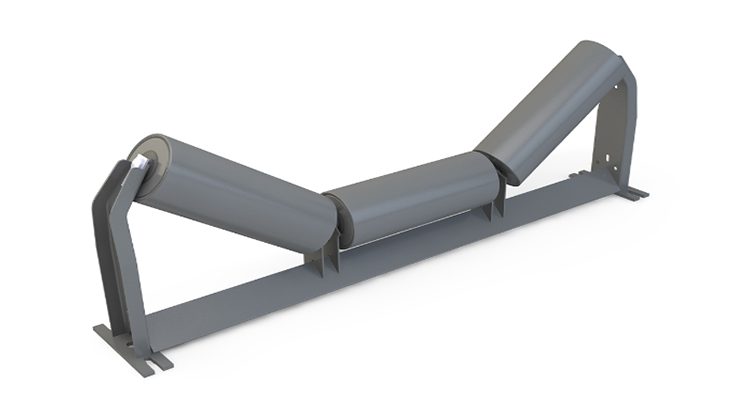
Return Idler
- Function: Positioned on the underside of the conveyor belt to support it on its return path. They ensure the belt moves smoothly and remains aligned.
- Applications: Essential for all conveyor systems, providing support to the return side of the belt to prevent sagging and misalignment.

V-Return Idler
- Function: A variation of the return idler that uses a ‘V’ shaped configuration to provide additional support and belt alignment in the return path, especially on longer conveyor systems.
- Applications: Used in heavy-duty applications where belt stability and longevity are critical, such as mining and aggregate industries.
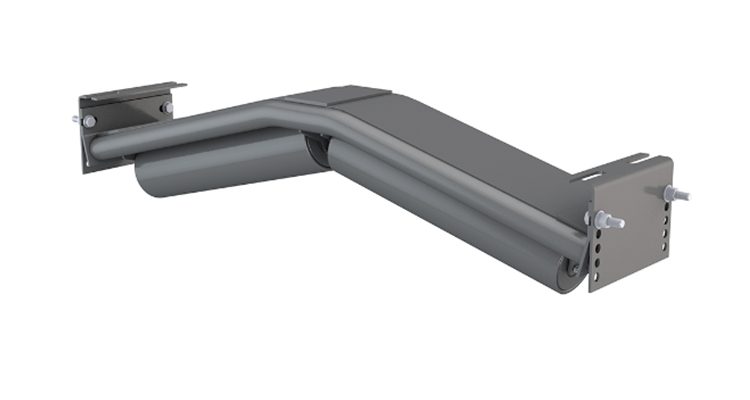
Impact Idler
- Function: Equipped with rubber rings or cushions to absorb the impact energy of falling materials at loading points, protecting the belt and system from damage.
- Applications: Ideal for conveyor sections where material is dropped onto the belt from a height, such as feed and transfer points.
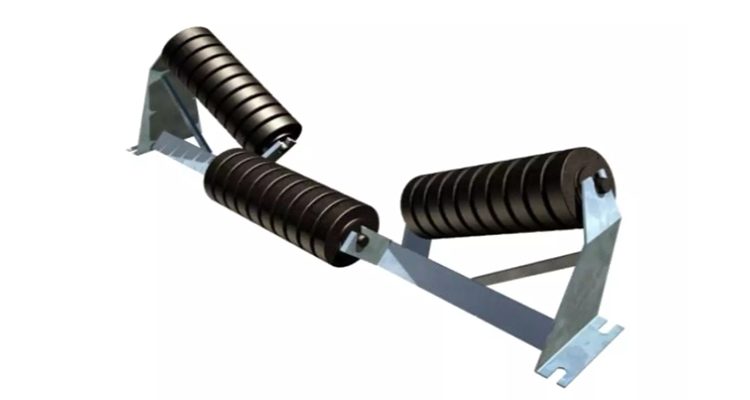
Transition Idler
- Function: Designed to facilitate the smooth transition of the conveyor belt from a flat to a troughed profile and vice versa, helping to maintain belt integrity.
- Applications: Placed near the head and tail pulleys where the belt transitions are critical to prevent material spillage and ensure belt longevity.
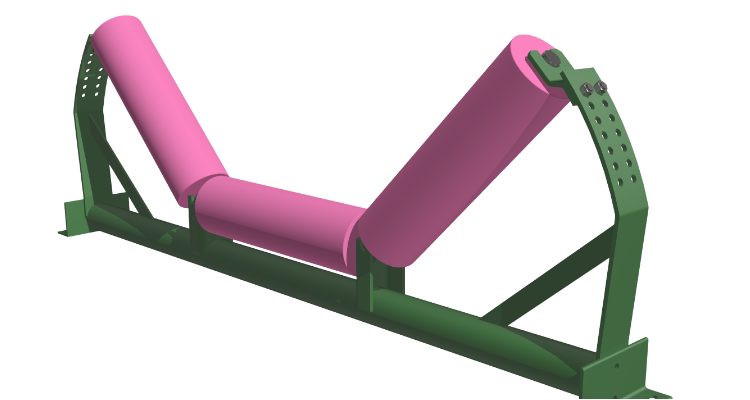
Self-Aligning Idler and Return
- Function: Automatically adjusts the belt position to correct any misalignment that may occur during operation, ensuring the belt travels in a straight path.
- Applications: Useful in sections of the conveyor where belt misalignment is likely due to external factors like wind, loading variations, or structural shifts.
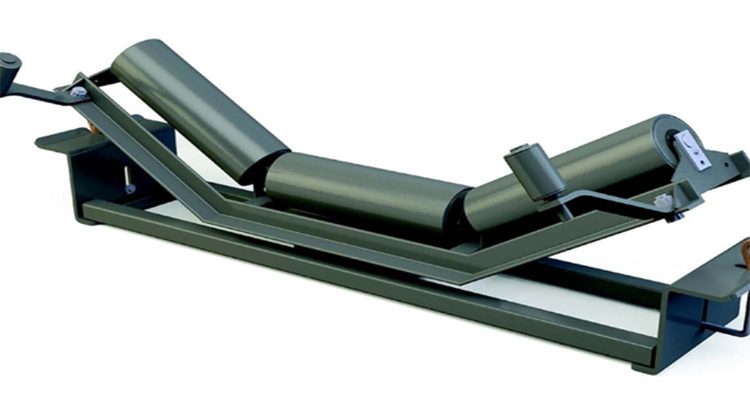
Picking/Feeding Idler
- Function: Features a flat or slightly troughed surface to facilitate manual or mechanical picking and sorting of materials directly from the belt.
- Applications: Common in recycling facilities, warehouses, and distribution centers where specific items need to be selected or sorted along the conveyor path.
Rubber Disc Return
- Function: Uses rubber discs instead of a continuous steel surface on the return idlers to reduce material build-up on the idler and the belt.
- Applications: Particularly useful in environments where sticky materials like mud or clay are conveyed, as the discs help to keep the belt clean and reduce maintenance.
Each idler style serves a unique purpose, enhancing the conveyor system’s functionality, safety, and efficiency. Choosing the appropriate idler type is crucial for optimal conveyor performance and longevity, tailored to the specific materials handled and the operational demands of the industry.
Functions of These Idlers in Conveyor Systems
Idlers play a crucial role in the operation and efficiency of conveyor systems, serving multiple functions that ensure the smooth, safe, and effective transportation of materials. Here’s a look at the primary functions of these idlers within conveyor systems:
Support and Shape the Conveyor Belt
- Troughing Idler: Creates a troughed shape to cradle the material being transported, which increases the carrying capacity of the conveyor belt and helps to contain the material, reducing spillage.
- Return Idler: Supports the return path of the conveyor belt, ensuring it remains stable and aligned.
- V-return Idler: Provides additional support and stability to the return side of the conveyor belt, particularly in long, high-tension systems.
Absorb Impact at Loading Points
- Impact Idler: Positioned at loading zones to absorb the shock and impact of material falling onto the belt, protecting both the belt and the structure from damage.
Facilitate Smooth Transitions
- Transition Idler: Ensures a smooth transition for the belt from flat to troughed sections and vice versa, minimizing stress and wear on the belt edges.
Maintain Belt Alignment
- Self-aligning Idler and Return: Detects and corrects any misalignment of the conveyor belt, reducing the risk of belt damage, spillage, and uneven wear.
Aid in Material Handling and Sorting
- Picking/Feeding Idler: Provides a stable and accessible surface for manual or mechanical picking and sorting of materials from the belt.
Prevent Build-up on the Belt
- Rubber Disc Return: The rubber discs effectively prevent the build-up of sticky or wet materials on the return belt, facilitating cleaner operation and reducing maintenance needs.
Overall, idlers are essential for:
- Extending the Lifespan of the Conveyor Belt: By providing proper support and reducing unnecessary stress, idlers help to prolong the life of the conveyor belt.
- Improving Operational Efficiency: Proper idler selection and placement can greatly enhance the conveyor system’s efficiency by ensuring smooth material flow, reducing downtime due to maintenance, and minimizing material loss.
- Enhancing Safety: By maintaining belt alignment and reducing spillage, idlers contribute to a safer working environment around conveyor systems.
The functions of these idlers underscore their importance in conveyor systems across various industries, highlighting the need for careful selection based on the specific requirements of the material handling application.
How to Use Continental Conveyor Idlers
Effectively utilizing Continental Conveyor Idlers involves understanding their installation, selecting the appropriate type for specific applications, and knowing the optimal spacing for carrying idlers.
Step-by-Step Guide on Installation and Usage
1. Preparation: Before installation, ensure you have the correct type and size of Continental Idlers for your conveyor system. Gather all necessary tools and safety equipment.
2. Positioning: Place the idler in the designated location along the conveyor frame. For carrying idlers, this will be along the upper part of the conveyor path, while return idlers will be on the lower part.
3. Mounting: Secure the idler onto the conveyor frame. This typically involves aligning the idler brackets with the frame and fastening them using bolts or similar hardware. Ensure that the idler is level and aligned with the conveyor belt’s path.
4. Adjustment: Once mounted, adjust the idler to ensure proper alignment of the conveyor belt. This may involve adjusting the angle or height of the idler, especially in the case of training idlers.
5. Testing: After installation, run the conveyor belt to check for proper idler function. Look for smooth belt movement and correct alignment. Make any necessary adjustments.
Selecting the Right Type of Idler
Assess the Application: Consider the type of material being conveyed, the load weight, and the conveyor belt speed. For heavier loads and higher speeds, more robust idlers like impact idlers may be required.
Environment Consideration: For environments with high levels of dust or moisture, select idlers with appropriate sealing and materials to withstand these conditions.
Special Requirements: For specific needs like belt alignment, choose self-aligning or training idlers. Troughing idlers are ideal for bulk material handling.
Distance Between Carrying Idlers
Impact on Performance: The spacing between carrying idlers affects the load distribution on the belt, belt wear, and energy efficiency. Incorrect spacing can lead to increased belt wear, material spillage, and decreased system efficiency.
Optimal Spacing: The optimal distance between carrying idlers depends on the belt width, material weight, and conveyor speed. Generally, heavier loads and wider belts require closer idler spacing. Consult Continental’s guidelines for specific recommendations.
Adjustment for Specific Conditions: In certain applications, such as high-impact loading zones, the idler spacing may need to be adjusted to provide additional support and reduce the stress on the conveyor belt.
Benefits of Using Continental Conveyor Idlers
Continental Conveyor Idlers are renowned for their quality and performance. This section delves into the advantages they offer, including enhanced durability, operational efficiency, and reduced maintenance costs, and how they contribute to the overall performance and longevity of conveyor systems.
Advantages of Continental Conveyor Idlers
1. Durability: One of the standout features of Continental idlers is their robust construction. Constructed from premium materials, these idlers endure heavy loads, abrasion, and harsh environments, offering durability and a longer lifespan, thus minimizing replacement frequency and costs.
2. Efficiency: Continental idlers are engineered for optimal efficiency. Their design reduces friction between the idler and belt, lowering energy use and wear, crucial for high throughput and smooth conveyor operation.
3. Reduced Maintenance Costs: Thanks to their durability and efficiency, Continental idlers require less frequent maintenance. This not only lowers direct maintenance costs but also minimizes downtime, ensuring that conveyor systems remain operational for longer periods. The ease of maintenance further adds to the cost-effectiveness of these idlers.
Contribution to Conveyor System Performance and Longevity
Enhanced System Performance: The use of Continental idlers directly impacts the overall performance of conveyor systems. By providing consistent and reliable support to the conveyor belt, continental conveyor idlers ensure smooth material flow and prevent common issues like belt misalignment, slippage, and spillage. This leads to improved operational efficiency and productivity.
Longevity of Conveyor Systems: The longevity of a conveyor system is significantly influenced by the quality of its components. Continental conveyor idlers, with their robust construction and efficient design, reduce the strain on the conveyor belt and other system components. These idlers extend the belt’s life and the system’s longevity, reducing repair and replacement needs, ensuring sustained functionality and productivity.
Adaptability and Versatility: Continental conveyor idlers are designed to be adaptable to a wide range of conveyor applications. Whether it’s handling bulk materials in mining operations or delicate products in manufacturing facilities, these idlers can be tailored to meet specific operational needs. This versatility further enhances their contribution to the overall effectiveness and longevity of conveyor systems.
The Application of Continental Conveyor Idlers
Continental conveyor idlers are versatile components used across a wide range of industries. Their adaptability and efficiency make them suitable for various applications, from heavy-duty material handling to delicate product transportation. This section explores the diverse industries where these idlers are employed and presents case studies to illustrate their effectiveness.
Industries and Scenarios Utilizing Continental Idlers
Continental idlers, known for their durability and efficiency, are utilized across a broad spectrum of industries and scenarios. Their design caters to the diverse needs of material handling systems, enhancing operational efficiency and safety. Here’s a look at various industries and scenarios where Continental idlers are crucial:
Mining and Minerals Processing
In the mining sector, continental conveyor idlers are used extensively for transporting raw materials like coal, ore, and aggregates. These environments demand idlers that can handle heavy loads and resist abrasive wear. Continental’s robust idlers are designed to meet these challenges, ensuring reliable operation in the demanding conditions of mining operations.
- Scenarios: Transporting raw extracted materials like coal, ore, and minerals over long distances in harsh, abrasive environments.
- Idler Use: Impact idlers absorb the shock of heavy, rough materials dropped onto belts, while troughing idlers support the weight and volume of dense materials.
Agriculture and Agribusiness
The agricultural industry utilizes conveyor systems for handling grains, feeds, and other bulk materials. Continental conveyor idlers in these settings are valued for their durability and efficiency. They ensure gentle handling of agricultural products, minimizing damage during transport.
- Scenarios: Moving bulk agricultural products such as grains, feed, and fertilizers through processing, storage, and shipping facilities.
- Idler Use: Picking/feeding idlers are used in sorting and processing, while self-aligning idlers ensure the belts carrying these materials stay on track, minimizing spillage.
Construction and Infrastructure
- Scenarios: Handling of raw building materials like sand, gravel, and crushed stone on construction sites and in material production facilities.
- Idler Use: Troughing and impact idlers are essential for supporting and absorbing the weight and impact of heavy construction materials.
Manufacturing and Production
In manufacturing, especially in automotive, electronics, and food processing, conveyor systems with continental conveyor idlers play a crucial role. They are used for assembly lines, processing, and packaging, where precision and reliability are paramount. The idlers’ efficient operation contributes to the smooth flow of materials, essential in maintaining high production standards.
- Scenarios: Conveyor systems in manufacturing plants for the automotive, electronics, and consumer goods industries, moving parts and finished products.
- Idler Use: Transition idlers ensure smooth belt operation as materials move through different stages of production, while self-aligning idlers maintain precise belt alignment crucial for automated processes.
Recycling and Waste Management
- Scenarios: Sorting and transporting recyclable materials or waste products for processing and disposal.
- Idler Use: Rubber disc return idlers help keep belts clean by shedding sticky or wet waste materials, and picking/feeding idlers facilitate manual sorting.
Food Processing and Packaging
- Scenarios: Conveying food products through various stages of processing, cooking, freezing, and packaging.
- Idler Use: Troughing idlers support belts carrying bulk food items, while specially designed, easy-to-clean idlers meet hygiene standards required in food handling.
Bulk Material Handling Terminals
- Scenarios: Ports, terminals, and storage facilities where bulk materials like grains, coal, and ores are loaded, unloaded, and stored.
- Idler Use: V-return idlers support heavy, loaded belts on long return paths, and impact idlers absorb the shock of materials being loaded onto ship loaders and unloaders.
Logistics and Distribution
- Scenarios: Conveyor systems in warehouses and distribution centers for sorting, loading, and unloading packages.
- Idler Use: Self-aligning idlers ensure that conveyor belts align correctly, reducing the risk of packages being misrouted or damaged during high-speed sorting operations.
In each of these industries and scenarios, the selection of the appropriate Continental idler style is key to achieving optimal performance, longevity, and safety of the conveyor system. The versatility and reliability of these idlers make them a preferred choice for enhancing material handling processes across a wide range of applications.
Case Studies Demonstrating Effectiveness
Case Study in Mining: A coal mine faced frequent conveyor breakdowns due to idler failures. After switching to Continental heavy-duty idlers, the mine saw a significant reduction in downtime. The durability of the idlers under heavy load and abrasive conditions led to increased operational efficiency and reduced maintenance costs.
Agricultural Application: A large grain handling facility implemented continental conveyor idlers for their conveyor system. The result was a notable improvement in the handling of grains, with reduced spillage and gentle transportation, leading to higher product quality and lower waste.
Manufacturing Success Story: An automotive manufacturer used continental conveyor idlers for their assembly line conveyors. The idlers’ precise operation and reliability contributed to a smoother assembly process, with fewer stoppages and consistent product movement, enhancing overall production efficiency.
These examples across various industries demonstrate the versatility and effectiveness of Continental Conveyor Idlers. Their ability to adapt to different operational needs and environments makes them an invaluable component in a wide range of material handling applications.
Innovations and Future Prospects in Continental Conveyor Idlers
Latest Innovations in Continental Conveyor Idlers
1. Advancements in Materials: Continental has been pioneering the use of new, more durable materials in the construction of conveyor idlers. These materials endure extreme abrasion, corrosion, and temperature variations, extending idler lifespan and enhancing energy efficiency by reducing conveyor system weight.
2. Design Innovations: There has been a significant focus on improving the design of idlers to enhance performance. This includes the development of idlers with better load distribution capabilities, reduced noise levels, and lower vibration. The design improvements also aim at easier installation and maintenance, reducing downtime and labor costs.
3. Smart Technology Integration: Continental is integrating smart technologies into their idlers, such as sensors for monitoring wear and tear, temperature, and load. This integration allows for predictive maintenance, where potential issues can be addressed before they lead to system failures, thereby enhancing efficiency and reducing unplanned downtime.
Future Trends in Conveyor Technology
Automation and Digitalization: The future of conveyor technology is moving towards increased automation and digitalization. Continental conveyor idlers are expected to play a significant role in this transition, developing more automated conveyor systems integrated with IoT and AI for real-time monitoring and decision-making.
Sustainability: There is a growing emphasis on sustainability in conveyor technology. Continental is likely to focus on developing eco-friendly idlers, using recyclable materials and designs that reduce energy consumption and carbon footprint.
Customization and Flexibility: As industries evolve, there is an increasing need for customized conveyor solutions. Continental is poised to offer more flexible and adaptable idler designs that can be tailored to specific industry needs and operational requirements.
Enhanced Safety Features: Safety remains a paramount concern in conveyor system design. Future innovations from Continental are expected to include advanced safety features, such as improved guarding and emergency stop mechanisms, to protect workers and reduce the risk of accidents.
FAQs about Continental Conveyor Idlers
There are several types of idlers, including carrying idlers, return idlers, impact idlers, self-aligning/training idlers, and troughing idlers.
Idlers support the conveyor belt and control its path, providing a smooth surface for the belt to travel over and helping to maintain tension and alignment.
The distance between carrying idlers varies based on conveyor design and load but typically ranges from 1 to 1.5 meters (3 to 5 feet).
An idler works by providing a rotating surface that supports and guides the conveyor belt, reducing friction and wear on the belt.
The three types of idler pulleys are flat idler pulleys, V-belt idler pulleys, and timing belt idler pulleys.
The three common types of conveyors are roller conveyors, belt conveyors, and chain conveyors.
Last Updated on July 1, 2024 by Jordan Smith
Jordan Smith, a seasoned professional with over 20 years of experience in the conveyor system industry. Jordan’s expertise lies in providing comprehensive solutions for conveyor rollers, belts, and accessories, catering to a wide range of industrial needs. From initial design and configuration to installation and meticulous troubleshooting, Jordan is adept at handling all aspects of conveyor system management. Whether you’re looking to upgrade your production line with efficient conveyor belts, require custom conveyor rollers for specific operations, or need expert advice on selecting the right conveyor accessories for your facility, Jordan is your reliable consultant. For any inquiries or assistance with conveyor system optimization, Jordan is available to share his wealth of knowledge and experience. Feel free to reach out at any time for professional guidance on all matters related to conveyor rollers, belts, and accessories.



